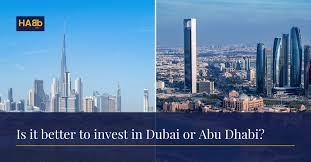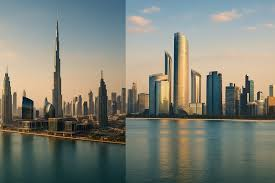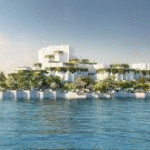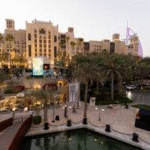Now Reading: Dubai vs Abu Dhabi Real Estate ROI: A Powerful Investor’s Look
-
01
Dubai vs Abu Dhabi Real Estate ROI: A Powerful Investor’s Look
Dubai vs Abu Dhabi Real Estate ROI: A Powerful Investor’s Look

Table of Contents
Dubai and Abu Dhabi, the two largest emirates in the UAE, both offer compelling opportunities for real estate investors. However, their markets possess distinct characteristics that cater to different investment appetites and objectives. When evaluating which market offers better Return on Investment (ROI), it’s crucial to consider factors like capital appreciation, rental yields, market stability, and investor demographics.

Understanding ROI in Real Estate
ROI in real estate is typically assessed through two main lenses:
- Capital Appreciation: The increase in the property’s value over time.
- Rental Yield: The annual income generated from rent as a percentage of the property’s purchase price.
A “good” ROI depends on your investment strategy – whether you prioritize quick capital gains, steady rental income, or long-term wealth preservation.
Dubai: The Dynamic Hub for Higher Potential Returns

Dubai has consistently been the poster child for the UAE’s real estate boom, known for its rapid growth, luxury developments, and global appeal. In 2025, Dubai continues to lead in several key ROI indicators:
- Higher Capital Appreciation: Dubai’s property market has seen significant price growth. Prime areas saw nearly 20% price growth in 2024, and forecasts for 2025 predict further increases of 5-10% overall. Ultra-luxury villas and branded residences are experiencing even more substantial appreciation, sometimes projected to rise by 30-40% over a five-year outlook. While the market can be more volatile due to its speculative nature, the potential for quick capital gains remains high.
- Stronger Rental Yields (Generally): Dubai typically offers higher rental yields compared to Abu Dhabi. Average rental yields in Dubai generally range between 6-8%, with some areas delivering even higher.
- High-Yield Areas for Apartments: International City (up to 8.81%), Dubai Sports City (around 8.91%), Jumeirah Village Circle (JVC) (7.5%-8% for studios and 1-beds), Arjan (up to 8.20%), Al Furjan (up to 8.75%), JLT (around 8.13% for studios), and Business Bay (around 6.66-6.96%).
- Luxury Yields: While prime luxury areas like Downtown Dubai and Palm Jumeirah might have lower gross rental yields due to higher entry prices (e.g., Palm Jumeirah studios up to 8.71%, 1-beds around 4.75%; Downtown Dubai studios up to 8.42%, 1-beds around 5.83%), they offer significant capital appreciation and prestige.
- Dominant Off-Plan Market: Over 60% of all transactions in Dubai in Q1 2025 were off-plan. This offers investors opportunities for buying at more affordable rates and benefiting from substantial appreciation upon project completion.
- Global Investor Interest: Dubai’s liberal lifestyle, tax-free environment, Golden Visa program (for investments over AED 2 million), and diverse property portfolio attract a wide range of international investors seeking high-growth opportunities.
Who is Dubai ideal for? Investors seeking high-growth investments, strong rental yields, a vibrant cosmopolitan lifestyle, and exposure to luxury real estate or short-term rental opportunities.
Abu Dhabi: The Stable Market for Consistent Returns

Abu Dhabi, the UAE’s capital, offers a more stable and less volatile real estate market. Its appeal lies in its long-term growth potential, family-friendly communities, and emphasis on cultural and sustainable development.
- Moderate Capital Appreciation: Abu Dhabi’s property price growth is more moderate, with increases of around 5-8% in prime areas like Al Reem Island, Saadiyat Island, and Yas Island. Overall, residential prices rose by 2.1% in Q1 2025 and 7.2% annually. Villa prices, in particular, saw strong growth at 2.7% in Q1 and 9.8% year-on-year. While slower than Dubai, this growth is often more sustainable.
- Solid Rental Yields: Abu Dhabi offers attractive and stable rental yields, averaging between 5-7% across the market. Some areas offer higher, comparable to Dubai’s mid-tier.
- High-Yield Areas: Al Reem Island (up to 7.64% for studios, 7.50% for 1-beds), Yas Island (up to 7.61% for studios, 6.99% for luxury apartments), Al Raha Beach (up to 7.04% for 1-beds), and Al Ghadeer (up to 8.69% for studios). Al Reef has shown strong returns, with villas at 6.23% and apartments at an impressive 10.08%.
- Stable Demand: Abu Dhabi sees a strong presence of domestic and GCC-based buyers, often prioritizing stability and long-term gains. High occupancy rates (exceeding 95% in many investment zones) and surging demand have led to significant rental increases (up to 12% in Q1 2025, with luxury rents up 8-12%).
- Government-Driven Development: Government initiatives to diversify the economy and ongoing mega-projects (e.g., Wynn Al Marjan Island in nearby Ras Al Khaimah, which positively impacts the broader Northern Emirates, and continued development on Yas and Saadiyat Islands) bolster market confidence and long-term value.
- More Affordable Entry: Generally, housing and living costs in Abu Dhabi are slightly lower than in Dubai, making it an excellent choice for families and those seeking a more affordable premium lifestyle.
Who is Abu Dhabi ideal for? Investors seeking long-term growth, stability, family-friendly communities with steady returns, and a potentially lower-risk profile.
Which Offers Better ROI? A Direct Comparison (2025 Outlook)
| Feature | Dubai (2025 Outlook) | Abu Dhabi (2025 Outlook) | Verdict for ROI |
|---|---|---|---|
| Capital Appreciation | Higher (5-10% general, more for luxury/off-plan) | Moderate (5-8% in prime areas) | Dubai (for aggressive growth) |
| Rental Yields | Generally higher (6-8% average, some areas up to 9%+) | Solid and stable (5-7% average, some areas up to 10%+) | Dubai (for higher average yields) |
| Market Volatility | More dynamic, higher potential for quick gains/dips | More stable, fewer speculative investors | Abu Dhabi (for risk-aaverse investors) |
| Investor Demographics | Global, HNWIs, short-term rental focused | Domestic, GCC, long-term stability, family-focused | Dubai (for international appeal) |
| Off-Plan Market | Very strong, high volume of new launches | Robust, but less volume than Dubai | Dubai (for sheer off-plan opportunity) |
| Cost of Living/Entry | Higher, especially in prime areas | Slightly more affordable overall | Abu Dhabi (for lower entry cost) |
| Long-term Outlook | Continued robust growth, global hub | Steady, sustainable growth, diversified economy | Both (strong fundamentals) |
Export to Sheets
Conclusion:
Based on current trends and the 2025 outlook:
- For investors prioritizing higher capital appreciation and aggressively chasing top rental yields, Dubai currently offers the better ROI potential. Its dynamic market, driven by continuous innovation, tourism, and a massive influx of international residents and businesses, provides more opportunities for rapid gains.
- For investors seeking stability, consistent income, lower entry costs, and a more predictable long-term growth trajectory, Abu Dhabi presents a compelling case. Its strong government backing, focus on sustainable development, and a growing yet more regulated market make it a safer bet for conservative investors and those looking to settle down.
Ultimately, the “better” ROI depends on an individual’s investment goals, risk tolerance, and time horizon. Both emirates offer robust and attractive real estate markets within the stable and tax-friendly environment of the UAE. Diversifying investments across both cities or focusing on specific high-performing areas within each can be a strategic approach to maximize returns.
WATCH MORE: https://www.youtube.com/watch?v=9C3T1l3QL7g
READ MORE: UAE REITs: Unlock Powerful Real Estate Investment Without Property






















